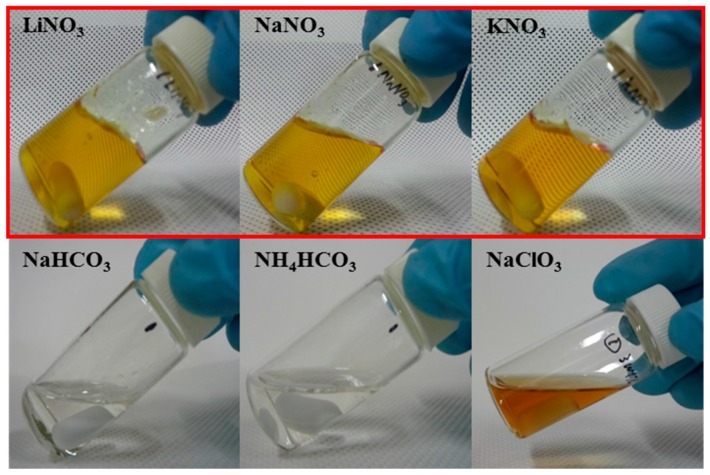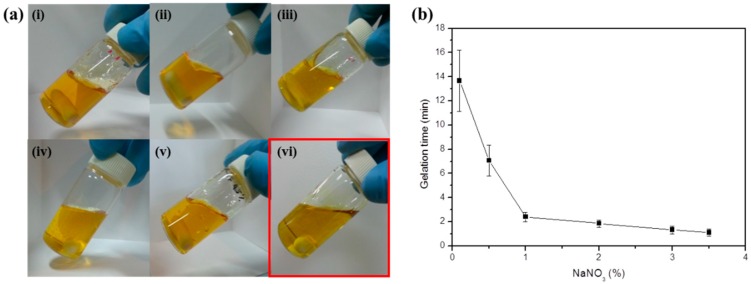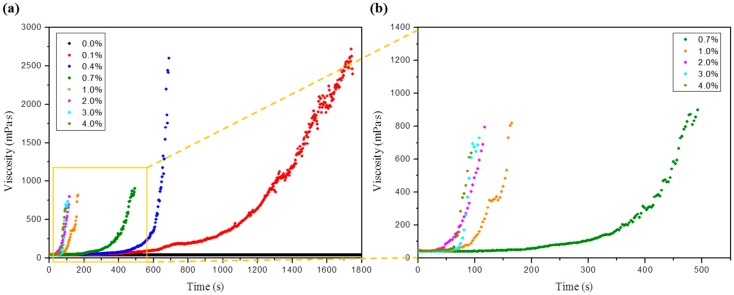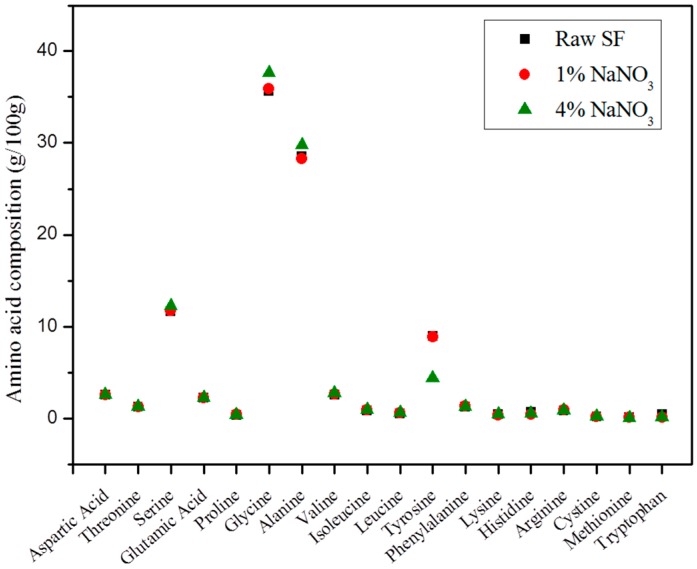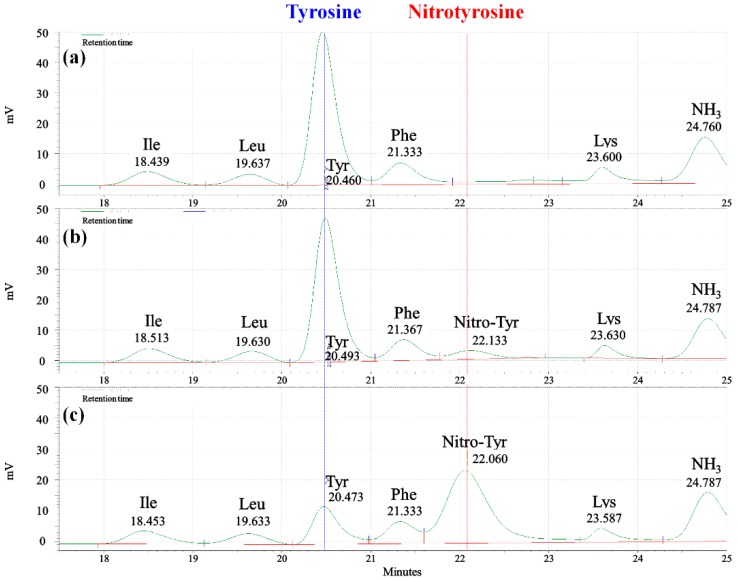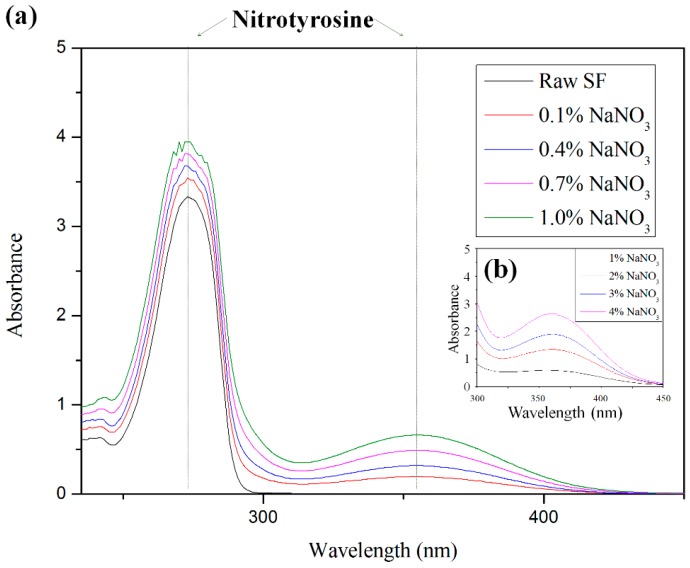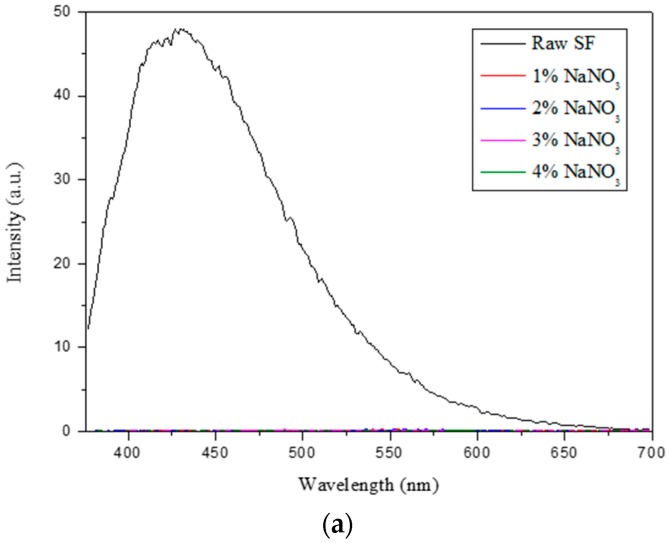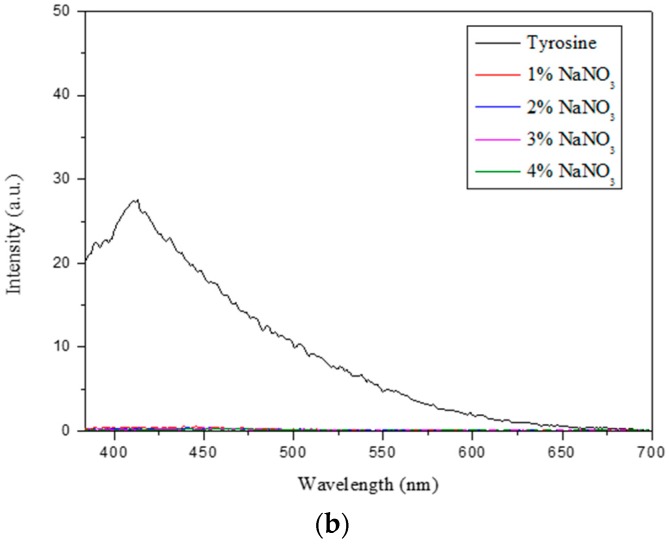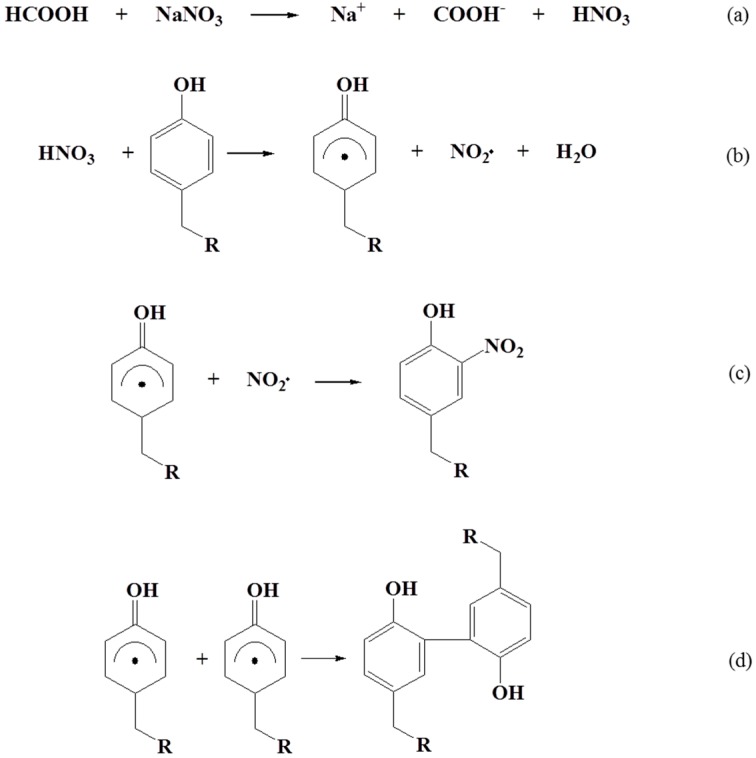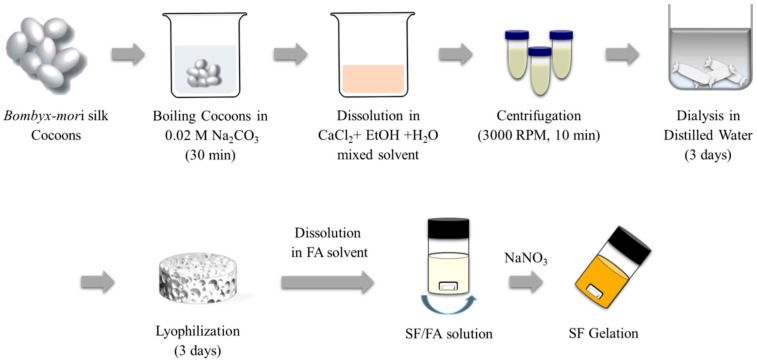Abstract
Silk fibroin (SF) is a typical fibrous protein that is secreted by silkworms and spiders. It has been used in a variety of areas, and especially for tissue-engineering scaffolds, due to its sound processability, mechanical properties, biodegradability, and biocompatibility. With respect to gelation, the SF gelation time is long in aqueous solutions, so a novel approach is needed to shorten this time. The solubility of regenerated SF is sound in formic acid (FA), which is a carboxylic acid of the simplest structure. In this study, SF was dissolved in formic acid, and the addition of salts then induced a rapid gelation that accompanied a solution-color change. Based on the gelation behaviors of the SF solution according to different SF and salt concentrations, the gelation mechanism was investigated.
Keywords: silk fibroin, gelation, nitration, tyrosine
1. Introduction
Silk, which is secreted by silkworms, spiders, mites, and pseudo-scorpions, is a generally fibrous protein that has attracted considerable attention due to its inherent optical and outstanding mechanical properties [1,2,3,4]. It has been widely used in high quality textile industries, but has recently played a significant role in the medical materials for surgical sutures and as a wound dressing with respect to membranes [5,6]. It has been known that silk mainly consists of two proteins whereby fibroin is a dominant component (75%), and that it is also hydrophobic [7,8]. Contrary to fibroin, sericin comprises a hydrophilic property with a fibroin encasement for protection. Fibroin is composed of a light chain with 26 kDa and a heavy chain with 350 kDa [9]. The structure has a strong influence on the strength and elasticity of silk. The amino acid composition of silk is made up of glycine, alanine and serine, all of which represent more than 90% of the total content [10]; their short side chains make intermolecular stacking interactions facilitative, and this leads to an antiparallel β-sheet structure of a high crystalline quality [11]. The primary protein structure of fibroin holds the hydrophobic protein structure of the natural block co-polymer [12].
The biocompatibility of fibroin is not only sound, but it also comprises transformable properties for the preparation of an aqueous solution by a variety of methods [13]. Due to its strong benefits, fibroin has been steadily researched in terms of cosmetics and food additives [14], and its application has recently been extended to fields such as artificial blood vessels, wound dressings, and drug delivery on account of its inherent biological properties [15].
The results from the gelation of fibroin include intermediate properties between liquids and solids, a porous structure, and elasticity by three-dimensional crosslinking [16]. A variety of methods have been introduced to gelate fibroin, for example a radical reaction using irradiation and a bridging reaction using chemical covalent bonds or cross-linking agents [17].
For all of their effective performances, such as the time necessary to gelate silk fibroin (SF) solution, a limitation still exists. In the reported SF gelation study, 1 to 50 h gelation times were spent to form the SF gel [18]. The aim of this study is to dramatically reduce the gelation time through the addition of salts. The proposed method induced a rapid gelation of SF solution and the gelation process was confirmed using diverse analysis methods [19,20,21].
2. Results and Discussion
2.1. Gelation Behavior of Silk Fibroin (SF)/Formic Acid Solution According to the Addition of a Variety of Salts
The addition of salts with nitrate in the SF/formic acid solution led to immediate gelation reactions. All of the salt concentrations were 3.5% of the SF weight, and the concentration of the SF/formic acid solution was 5%. Interestingly, a fast reaction rate was shown when nitrate-type salts such as sodium nitrate (NaNO3), lithium nitrate (LiNO3), and potassium nitrate (KNO3) were treated (Figure 1). However, when salts without nitrate such as sodium bicarbonate (NaHCO3) and ammonium bicarbonate (NH4HCO3) were added to the solution, no changes were observed. After the addition of NaClO3, a brownish color was observed without gelation. This finding indicates that the gelation reaction of the SF/formic acid solution is derived from the addition of the nitrate salts, and the nitrate salts induced the growth of the solution as yellowish gels. The reaction was completed within a few minutes and yellow gels were obtained.
Figure 1.
Gelation behaviors of silk fibroin (SF)/formic acid solution according to the addition of salts. The red parts indicate gelated SF solutions according to the addition of nitrate-type salts.
2.2. Effect of SF and NaNO3 Concentration on Gelation
The gelation behavior was observed under varying concentrations of the SF/formic acid solution where NaNO3 is a representative nitrate salt. In the 3% to 8% SF/formic acid solution with 3.5% NaNO3, gelation occurred above the 4.5% SF concentrations (Figure 2).
Figure 2.
Concentration effect of the SF/formic acid solution on gelation: (a) 3% SF; (b) 3.5% SF; (c) 4% SF; and (d) 4.5% SF. The red part indicates a gelated SF solution at a 4.5% SF concentration.
For the gelation of SF, the minimum concentration of the SF/formic acid solution is 4.5%. Also in the 0.1% to 4% NaNO3 and 4.5% SF concentrations, gelation occurred below the 3.5% NaNO3 concentration. The maximum gelation concentration of NaNO3 is 3.5% at a 4.5% SF/formic acid solution (Figure 3a(i–vi)). When 0.1% NaNO3 was added to the SF/formic acid solution, the gelation time was 14 min, while the gelation of the 3.5% NaNO3 took 1 min. Therefore, the gelation times of the SF/formic acid were decreased under high concentrations of NaNO3 due to the increased gelation reaction rate (Figure 3b). Gelation time was measured below 3.5% NaNO3 because at 4% NaNO3, gelation did not occur. Further experiments were performed at a 5% SF concentration to obtain stable SF gels.
Figure 3.
(a) Effect of NaNO3 concentration on gelation: (i) 0.1% NaNO3; (ii) 0.5% NaNO3; (iii) 1% NaNO3; (iv) 3% NaNO3; (v) 3.5% NaNO3 and (vi) 4% NaNO3; (b) Gelation time of SF solution according to NaNO3 concentration. The red part indicates a non-gelated SF solution at a 4% NaNO3 concentration.
2.3. Viscosity Change According to the NaNO3 Concentration
The addition of NaNO3 to the SF/formic acid solution induced an increased viscosity regarding the gelation reaction. The viscosities were therefore analyzed according to the addition of diverse NaNO3 concentrations (Figure 4). Before the addition of NaNO3, the viscosity of the SF/formic acid solution was similar to water, but the high NaNO3 concentrations showed a low viscosity during gelation. The concentration of the NaNO3 was decreased, the viscosity of the SF gel became higher, and the gel stability was improved.
Figure 4.
Viscosity change of SF gel depending on concentration of NaNO3: (a) viscosity change of SF gel from 0% to 4% NaNO3 concentrations and (b) the expanded viscosity change of SF gel at high NaNO3 concentrations (from 0.7% to 4%).
2.4. Compositional Change of SF upon Gelation
2.4.1. Amino Acid Analysis
SF consists of 18 amino acids including Gly, Ala, Ser, and Tyr, and this amino acid composition was investigated according to the SF gelation (Figure 5). The concentration of the SF/formic acid is 5%, and except for tyrosine, content changes were not observed in the amino acids of the SF gel. Tyrosine content decreased when the NaNO3 concentration increased and a nitrotyrosine peak appeared (Figure 6). A standard test using 3-nitro-l-tyrosine confirmed that the nitration of the tyrosine modified it to nitrotyrosine. The nitrotyrosine content was increased when the NaNO3 concentration was increased.
Figure 5.
Amino acid composition of SF gel depending on the NaNO3 concentration.
Figure 6.
Contents of tyrosine and nitrotyrosine in SF gel depending on the NaNO3 concentrations: (a) Raw SF; (b) 1% NaNO3; and (c) 4% NaNO3.
2.4.2. UV-Vis Spectroscopy
The functional SF groups were investigated upon gelation using a UV-vis spectrophotometer (UV-2450, Shimadzu, Japan) (Figure 7). As the NaNO3 concentration increased, typical nitrotyrosine peaks increased at 274 nm and 356 nm [22], indicating that the tyrosine reacted to the NaNO3, and that the nitration of the SF modified the tyrosine to nitrotyrosine. This finding is consistent with the results of the amino acid analysis of the SF gel [23].
Figure 7.
UV-vis spectroscopy results of SF gels depending on the NaNO3 concentration: (a) 0% to 1% NaNO3 and (b) 1% to 4% NaNO3.
2.5. Fluorescence Spectroscopy
The fluorescence intensity change upon gelation was observed through the fluorescence property of the tyrosine in the SF (Figure 8). When gelation occurred in the SF/formic acid solution, the fluorescence intensity of tyrosine at 426 nm (excitation wavelength: 365 nm) was decreased by the increase of the NaNO3 concentration. In a control experiment for which the tyrosine/formic acid solution was used, when the NaNO3 concentration was treated, the tyrosine fluorescence intensity at 416 nm was decreased in a similar manner as the original solution, indicating that the tyrosine content decreased upon gelation due to the nitration of the tyrosine in the SF [24].
Figure 8.
Fluorescence intensity comparison of SF gels: (a) 1% to 4% NaNO3 and (b) with tyrosine/formic acid solution (Excitation wavelength: 365 nm).
2.6. Mechanism of SF Gelation and Nitration
The solubility of SF in water is low because of its hydrophobic property, but it was easily dissolved in the formic acid. When NaNO3 was dissolved in the SF/formic acid solution, it was dissociated in the formic acid solvent and reacted with the hydrogen cation to form NO3− (Figure 9a). The tyrosine reacted with the NO3−-synthesized tyrosyl radical and NO2 radical (NO2∙) (Figure 9b). The prepared NO2∙ might be formed to nitrotyrosine through a nitration reaction between the NO2∙ and tyrosyl radical. Also, the two tyrosyl radical groups probably cross-linked with each other to form a dityrosine structure [25,26]. In addition, this was followed by the induction of the gelation in the SF/formic acid solution (Figure 9c,d). For a confirmation of this mechanism, a further study will be performed.
Figure 9.
Gelation mechanism of SF/formic acid solution with NaNO3. (a) addition of NaNO3; (b) tyrosyl radical formation; (c) nitration of tyrosine; (d) cross-linking of tyrosine.
3. Materials and Methods
3.1. Materials
The raw silk was reeled off the cocoons of the Bombyx mori silkworm. The three types of nitrate salts NaNO3, LiNO3, and KNO3 were used, and these salts were purchased from Samchun (Pyeongtaek, Korea). The three types of non-nitrate salts NaClO3, NaHCO3, and NH4HCO3 that were obtained from Sigma–Aldrich (St. Louis, MO, USA) were used, and these salts were used as additives in the SF solution. The formic acid (98%) was purchased from Junsei (Tokyo, Japan). The l-tyrosine and 3-nitro-l-tyrosine were also purchased from Sigma-Aldrich.
3.2. Preparation of SF/Formic Acid Solution
Raw-silk fibers were degummed using a 0.5% (w/w) sodium bicarbonate (NaHCO3) solution at 100 °C for 30 min before they were rinsed with warm distilled water [27]. While the degummed silk fibroin was insoluble in formic acid, the regenerated SF was readily soluble in formic acid [28]. The degummed SF was dissolved in a ternary solvent system of calcium chloride/ethanol/water (1:2:8 in molar ratio) at 85 °C for 4 h. After dialysis with a cellulose tubular membrane (molecular cut-off, 12,000) in distilled water for three days, the aqueous SF solution was filtered and freeze-dried to obtain regenerated SF sponges [29,30]. The SF solution was prepared by dissolving the regenerated SF sponges in formic acid for 30 min [28].
3.3. Gelation Behavior of SF/Formic Acid Solution According to the Addition of a Variety of Salts
Gelation was observed with the transparent SF/formic acid solution that had been prepared with the addition of a variety of salts according to concentrations of 1 wt % to 4 wt %, based on the SF weight (Figure 10). For the effective gelation of the SF, NaNO3 was selected as a salt, and its gelation behavior was observed according to the SF and NaNO3 concentrations.
Figure 10.
Scheme of SF gelation process using regenerated SF. RPM represents rotation per minute.
3.4. Characterization
3.4.1. Viscosity Change Depending on the NaNO3 Concentration
The gelation of SF generally induced an abrupt increase in the viscosity. Also, the viscosity of SF gel was associated with the degree of cross-linking. Viscosity changes of the SF/formic acid solution depending on various concentrations (0.1% to 4%) of NaNO3 were observed using a viscometer (HADB-III U, Brookfield, MA, USA). The SF concentration was fixed at 5%.
3.4.2. Amino Acid Analysis
SF is consisted of 18 amino acids including Gly, Ala, Ser, and Tyr. Amino acid analysis was conducted to investigate the change in the amino acid composition on gelation. To observe the compositional change, the solvent of SF gel was replaced with water and then analyzed using amino acid analysis (HITACH L-8900, Tokyo, Japan).
3.4.3. UV-Vis Spectrophotometry
Tyrosine and nitrotyrosine residues in the SF gel were able to absorb UV-vis light [31]. On the SF gelation, the absorbance was varied with the tyrosine content. While the NaNO3 salt was added to the SF solution, the absorbance change was characterized by the UV-vis spectrophotometer (UV-2450, Shimadzu, Kyoto, Japan). A quartz cell was used and the solution was analyzed at wavelengths of 200 nm to 800 nm.
3.4.4. Fluorescence Spectroscopy
Furthermore, the SF gel was observed using a fluorescent spectrophotometer. To analyze the changes in the structure and composition of the SF gels in both the solution and the dry state, respectively, a fluorescence photometer (Varian cary clipse, Varian, Middelburg, The Netherlands) was used. The excitation wavelength was 365 nm, and the emission wavelength was from 376 to 700 nm.
4. Conclusions
The fast gelation of a Bombyx mori SF/formic acid solution was induced by the addition of nitrate salts. The salts with nitrate stimulated the consumption of tyrosine and the generation of nitrotyrosine and dityrosine, and this reaction in the tyrosine residue led to an SF organogel. The gelation of the SF was greatly influenced by the amount of NaNO3. The SF gelation occurred within a few minutes at below 4% NaNO3 in a 5% SF/formic acid solution, but the SF gelation did not occur at above that condition, owing to the viscosity reduction of the gel. In this study, a unique way to promptly and efficiently fabricate the SF organogel is suggested, and if the SF organogel can be transformed to the SF hydrogel by a solvent exchange, the SF gel will be applicable to a variety of fields.
Acknowledgments
This study was supported financially by the National Research Foundation of Korea (NRF-2015R1A2A2A01007954).
Author Contributions
Won Ho Park conceived and designed the experiments; Dong Su Im performed the experiments; Dong Su Im and Min Hee Kim analyzed the data; Min Hee Kim contributed reagents/materials/analysis tools; Young Il Yoon wrote the paper.
Conflicts of Interest
The authors declare no conflict of interest.
References
- 1.Jin H.-J., Kaplan D.L. Mechanism of silk processing in insects and spiders. Nature. 2003;424:1057–1061. doi: 10.1038/nature01809. [DOI] [PubMed] [Google Scholar]
- 2.Seidel A., Liivak O., Calve S., Adaska J., Ji G., Yang Z., Grubb D., Zax D.B., Jelinski L.W. Regenerated spider silk: Processing, properties, and structure. Macromolecules. 2000;33:775–780. doi: 10.1021/ma990893j. [DOI] [Google Scholar]
- 3.Jiang C., Wang X., Gunawidjaja R., Lin Y.H., Gupta M.K., Kaplan D.L., Naik R.R., Tsukruk V.V. Mechanical properties of robust ultrathin silk fibroin films. Adv. Funct. Mater. 2007;17:2229–2237. doi: 10.1002/adfm.200601136. [DOI] [Google Scholar]
- 4.Hunt S. Amino acid composition of silk from the pseudoscorpion Neobisium maritimum (Leach): A possible link between the silk fibroins and the keratins. Comp. Biochem. Physiol. 1970;34:773–776. doi: 10.1016/0010-406X(70)90998-9. [DOI] [PubMed] [Google Scholar]
- 5.Cai Z.-X., Mo X.-M., Zhang K.-H., Fan L.-P., Yin A.-L., He C.-L., Wang H.-S. Fabrication of chitosan/silk fibroin composite nanofibers for wound-dressing applications. Int. J. Mol. Sci. 2010;11:3529–3539. doi: 10.3390/ijms11093529. [DOI] [PMC free article] [PubMed] [Google Scholar]
- 6.Santin M., Motta A., Freddi G., Cannas M. In vitro evaluation of the inflammatory potential of the silk fibroin. J. Biomed. Mater. Res. 1999;46:382–389. doi: 10.1002/(SICI)1097-4636(19990905)46:3<382::AID-JBM11>3.0.CO;2-R. [DOI] [PubMed] [Google Scholar]
- 7.Kim U.-J., Park J., Kim H.J., Wada M., Kaplan D.L. Three-dimensional aqueous-derived biomaterial scaffolds from silk fibroin. Biomaterials. 2005;26:2775–2785. doi: 10.1016/j.biomaterials.2004.07.044. [DOI] [PubMed] [Google Scholar]
- 8.Hofmann S., Foo C.W.P., Rossetti F., Textor M., Vunjak-Novakovic G., Kaplan D., Merkle H., Meinel L. Silk fibroin as an organic polymer for controlled drug delivery. J. Control. Release. 2006;111:219–227. doi: 10.1016/j.jconrel.2005.12.009. [DOI] [PubMed] [Google Scholar]
- 9.Mondal M. The silk proteins, sericin and fibroin in silkworm, Bombyx mori Linn.—A review. Casp. J. Environ. Sci. 2007;5:63–76. [Google Scholar]
- 10.Schroeder W., Kay L.M., Lewis B., Munger N. The amino acid composition of Bombyx mori silk fibroin and of tussah silk fibroin. J. Am. Chem. Soc. 1955;77:3908–3913. doi: 10.1021/ja01619a066. [DOI] [Google Scholar]
- 11.Fossey S.A., Némethy G., Gibson K.D., Scheraga H.A. Conformational energy studies of β-sheets of model silk fibroin peptides. I. Sheets of poly (Ala-Gly) chains. Biopolymers. 1991;31:1529–1541. doi: 10.1002/bip.360311309. [DOI] [PubMed] [Google Scholar]
- 12.Kim M.H., Park W.H. Chemically cross-linked silk fibroin hydrogel with enhanced elastic properties, biodegradability, and biocompatibility. Int. J. Nanomed. 2016;11:2967. doi: 10.2147/IJN.S106467. [DOI] [PMC free article] [PubMed] [Google Scholar]
- 13.Yamada H., Nakao H., Takasu Y., Tsubouchi K. Preparation of undegraded native molecular fibroin solution from silkworm cocoons. Mater. Sci. Eng. C. 2001;14:41–46. doi: 10.1016/S0928-4931(01)00207-7. [DOI] [Google Scholar]
- 14.Padamwar M., Pawar A. Silk sericin and its applications: A review. J. Sci. Ind. Res. 2004;63:323–329. [Google Scholar]
- 15.Vepari C., Kaplan D.L. Silk as a biomaterial. Prog. Polym. Sci. 2007;32:991–1007. doi: 10.1016/j.progpolymsci.2007.05.013. [DOI] [PMC free article] [PubMed] [Google Scholar]
- 16.Nazarov R., Jin H.-J., Kaplan D.L. Porous 3-D scaffolds from regenerated silk fibroin. Biomacromolecules. 2004;5:718–726. doi: 10.1021/bm034327e. [DOI] [PubMed] [Google Scholar]
- 17.Nagarkar S., Lele A., Chassenieux C., Nicolai T., Durand D., Co A., Leal G.L., Colby R.H., Giacomin A.J. Aip Conference Proceedings. AIP; Monterey, CA, USA: 2008. Gelation of Regenerated Fibroin Solution; p. 573. [Google Scholar]
- 18.Wang X., Kluge J.A., Leisk G.G., Kaplan D.L. Sonication-induced gelation of silk fibroin for cell encapsulation. Biomaterials. 2008;29:1054–1064. doi: 10.1016/j.biomaterials.2007.11.003. [DOI] [PMC free article] [PubMed] [Google Scholar]
- 19.Wu X., Hou J., Li M., Wang J., Kaplan D.L., Lu S. Sodium dodecyl sulfate-induced rapid gelation of silk fibroin. Acta Biomater. 2012;8:2185–2192. doi: 10.1016/j.actbio.2012.03.007. [DOI] [PubMed] [Google Scholar]
- 20.Park C.H., Jeong L., Cho D., Kwon O.H., Park W.H. Effect of methylcellulose on the formation and drug release behavior of silk fibroin hydrogel. Carbohydr. Polym. 2013;98:1179–1185. doi: 10.1016/j.carbpol.2013.07.028. [DOI] [PubMed] [Google Scholar]
- 21.Xiao W., He J., Nichol J.W., Wang L., Hutson C.B., Wang B., Du Y., Fan H., Khademhosseini A. Synthesis and characterization of photocrosslinkable gelatin and silk fibroin interpenetrating polymer network hydrogels. Acta Biomater. 2011;7:2384–2393. doi: 10.1016/j.actbio.2011.01.016. [DOI] [PMC free article] [PubMed] [Google Scholar]
- 22.Yang H., Zhang Y., Pöschl U. Quantification of nitrotyrosine in nitrated proteins. Anal. Bioanal. Chem. 2010;397:879–886. doi: 10.1007/s00216-010-3557-3. [DOI] [PMC free article] [PubMed] [Google Scholar]
- 23.Whittaker J.L., Choudhury N.R., Dutta N.K., Zannettino A. Facile and rapid ruthenium mediated photo-crosslinking of Bombyx mori silk fibroin. J. Mater. Chem. B. 2014;2:6259–6270. doi: 10.1039/C4TB00698D. [DOI] [PubMed] [Google Scholar]
- 24.Pfeiffer S., Schmidt K., Mayer B. Dityrosine formation outcompetes tyrosine nitration at low steady-state concentrations of peroxynitrite implications for tyrosine modification by nitric oxide/superoxide in vivo. J. Biol. Chem. 2000;275:6346–6352. doi: 10.1074/jbc.275.9.6346. [DOI] [PubMed] [Google Scholar]
- 25.DiMarco T., Giulivi C. Current analytical methods for the detection of dityrosine, a biomarker of oxidative stress, in biological samples. Mass Spectrom. Rev. 2007;26:108–120. doi: 10.1002/mas.20109. [DOI] [PubMed] [Google Scholar]
- 26.Van der Vliet A., Eiserich J.P., Shigenaga M.K., Cross C.E. Reactive nitrogen species and tyrosine nitration in the respiratory tract: Epiphenomena or a pathobiologic mechanism of disease? Am. J. Respir. Crit. Care Med. 1999;160:1–9. doi: 10.1164/ajrccm.160.1.9807044. [DOI] [PubMed] [Google Scholar]
- 27.Sah M., Pramanik K. Regenerated silk fibroin from B. mori silkcocoon for tissue engineering applications. Int. J. Environ. Sci. Dev. 2010;1:404. doi: 10.7763/IJESD.2010.V1.78. [DOI] [Google Scholar]
- 28.Um I.C., Kweon H., Park Y.H., Hudson S. Structural characteristics and properties of the regenerated silk fibroin prepared from formic acid. Int. J. Biol. Macromol. 2001;29:91–97. doi: 10.1016/S0141-8130(01)00159-3. [DOI] [PubMed] [Google Scholar]
- 29.Kim H.H., Song D.W., Kim M.J., Ryu S.J., Um I.C., Ki C.S., Park Y.H. Effect of silk fibroin molecular weight on physical property of silk hydrogel. Polymer. 2016;90:26–33. doi: 10.1016/j.polymer.2016.02.054. [DOI] [Google Scholar]
- 30.Zhang Q., Yan S., Li M. Silk fibroin based porous materials. Materials. 2009;2:2276–2295. doi: 10.3390/ma2042276. [DOI] [Google Scholar]
- 31.Crow J.P., Beckman J.S. Quantitation of Protein Tyrosine, 3-Nitrotyrosine, and 3-Aminotyrosine Utilizing HPLC and Intrinsic Ultrviolet Absorbance. Methods. 1995;7:116–120. doi: 10.1006/meth.1995.1017. [DOI] [Google Scholar]



